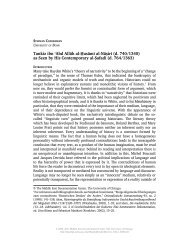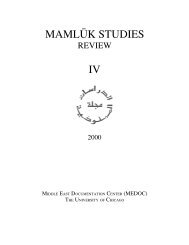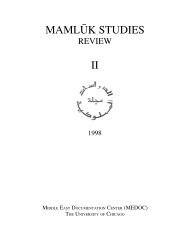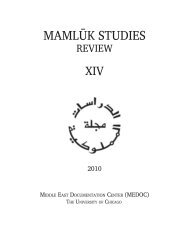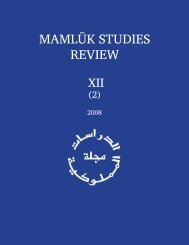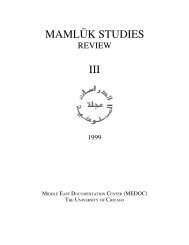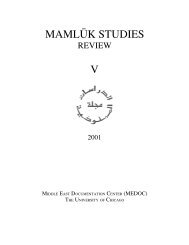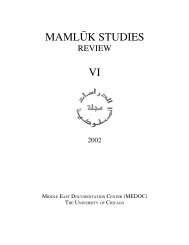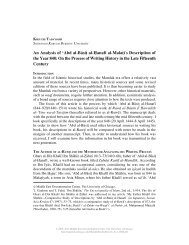Vol. VIII, no. 2 (2004) - Mamluk Studies Review - University of Chicago
Vol. VIII, no. 2 (2004) - Mamluk Studies Review - University of Chicago
Vol. VIII, no. 2 (2004) - Mamluk Studies Review - University of Chicago
Create successful ePaper yourself
Turn your PDF publications into a flip-book with our unique Google optimized e-Paper software.
MAMLU±K STUDIES REVIEW VOL. 8, NO. 2, <strong>2004</strong> 5<br />
pastoralists or <strong>no</strong>mads. The decisive elements <strong>of</strong> their bedouin identity—that<br />
which makes them badw—are rather their memory <strong>of</strong> a lineage associated with a<br />
distant <strong>no</strong>madic past, and their adherence to ideologies <strong>of</strong> equality and auto<strong>no</strong>my. 15<br />
I would contend here that a clear distinction between pastoral <strong>no</strong>madism as an<br />
eco<strong>no</strong>mic option, tribalism as a form <strong>of</strong> social organization, and bedouin-ness as a<br />
cultural identity allows for a richer interpretation <strong>of</strong> the resistance <strong>of</strong> the ‘urba≠n to<br />
<strong>Mamluk</strong> rule. Such a conceptual distinction also makes it possible to distill much<br />
more precisely the meaning <strong>of</strong> tribal identity in the medieval Egyptian countryside,<br />
and to place the tribes right at the center—rather than at the margins—<strong>of</strong> Egyptian<br />
history. Moreover, it also sheds a much-needed light on the process <strong>of</strong> conversion<br />
and Islamization outside <strong>of</strong> the urban centers. In order to do that, we need to<br />
re-visit al-Na≠bulus|'s Ta≠r|kh al-Fayyu≠m, the most detailed account <strong>of</strong> a rural<br />
province that has reached us from medieval Islamic Egypt. Al-Na≠bulus| visited<br />
the Fayyum only a decade before the outbreak <strong>of</strong> the first Arab rebellion against<br />
the <strong>Mamluk</strong>s, and I would argue that what al-Na≠bulus| saw in the 1240s can be<br />
generalized for other parts <strong>of</strong> Middle and Upper Egypt. The tribes <strong>of</strong> the Fayyum,<br />
seen through the eyes <strong>of</strong> al-Na≠bulus|, are crucial for a proper interpretation <strong>of</strong> the<br />
Arab revolts in the century that followed.<br />
The account <strong>of</strong> the province <strong>of</strong> the Fayyum written by the Ayyubid <strong>of</strong>ficial Abu≠<br />
‘Uthma≠n al-Na≠bulus|, entitled Ta≠r|kh al-Fayyu≠m wa-Bila≠dihi, is the most detailed<br />
cadastral survey to have survived from medieval Egypt. 16 In the words <strong>of</strong> Stephen<br />
Humphreys, it is "as close as we will ever get to an <strong>of</strong>ficial tax register for<br />
15 Tariq Tell, "The Politics <strong>of</strong> Rural Policy in East Jordan, 1920–1989," in The Transformation <strong>of</strong><br />
Nomadic Society, 90–98; Andrew J. Shryock, "Popular Genealogical Nationalism: History Writing<br />
and Identity among the Balqa Tribes <strong>of</strong> Jordan," Comparative <strong>Studies</strong> in History and Society 37,<br />
<strong>no</strong>. 2 (1995): 325–57.<br />
16 Abu≠ ‘Uthma≠n al-Na≠bulus|, Ta≠r|kh al-Fayyu≠m wa-Bila≠dihi (Description du Faiyoum), ed. B.<br />
Moritz (Cairo, 1898; repr., Beirut, 1974). George Salmon, "Répertoire géographique de la province<br />
du Fayyoûm d'aprés le Kitâb Târîkh al-Fayyoûm d'an-Naboûlsi," Bulletin de l'Institut français<br />
d'archéologie orientale 1 (1901): 29–77, provides a brief summary for each village. For a discussion<br />
<strong>of</strong> tax obligations, see Claude Cahen, "Le régime des impôts dans le Fayyu≠m Ayyu≠bide," Arabica<br />
3 (1958): 8–30 (reprinted in idem, Makhzu≠miyya≠t [Leiden, 1977]). On production and irrigation,<br />
see Sato, State and Rural Society, 215–24; I. König, "Die Oase al-Fayyum nach ‘Uthma≠n ibn<br />
Ibrahim an-Nabulusi: ein Beitrage zur Wirtchaftsgeschichte Aegyptens um die Mitte des 13.<br />
Jahrhunderts n. chr.," Zeitschrift für Geschichte der Arabisch-Islamischer Wissenschaft 10 (1996):<br />
190–253. For a useful recent summary, see G. Keenan, "Fayyum Agriculture at the End <strong>of</strong> the<br />
Ayyubid Era: Nabulsi's Survey," in Agriculture in Egypt: From Pharaonic to Modern Times, ed.<br />
Alan K. Bowman and Eugene Rogan, Proceedings <strong>of</strong> the British Academy 96 (Oxford, 1999),<br />
287–99.<br />
© <strong>2004</strong>, 2012 Middle East Documentation Center, The <strong>University</strong> <strong>of</strong> <strong>Chicago</strong>.<br />
http://mamluk.uchicago.edu/<strong>Mamluk</strong><strong>Studies</strong><strong>Review</strong>_<strong>VIII</strong>-2_<strong>2004</strong>.pdf



